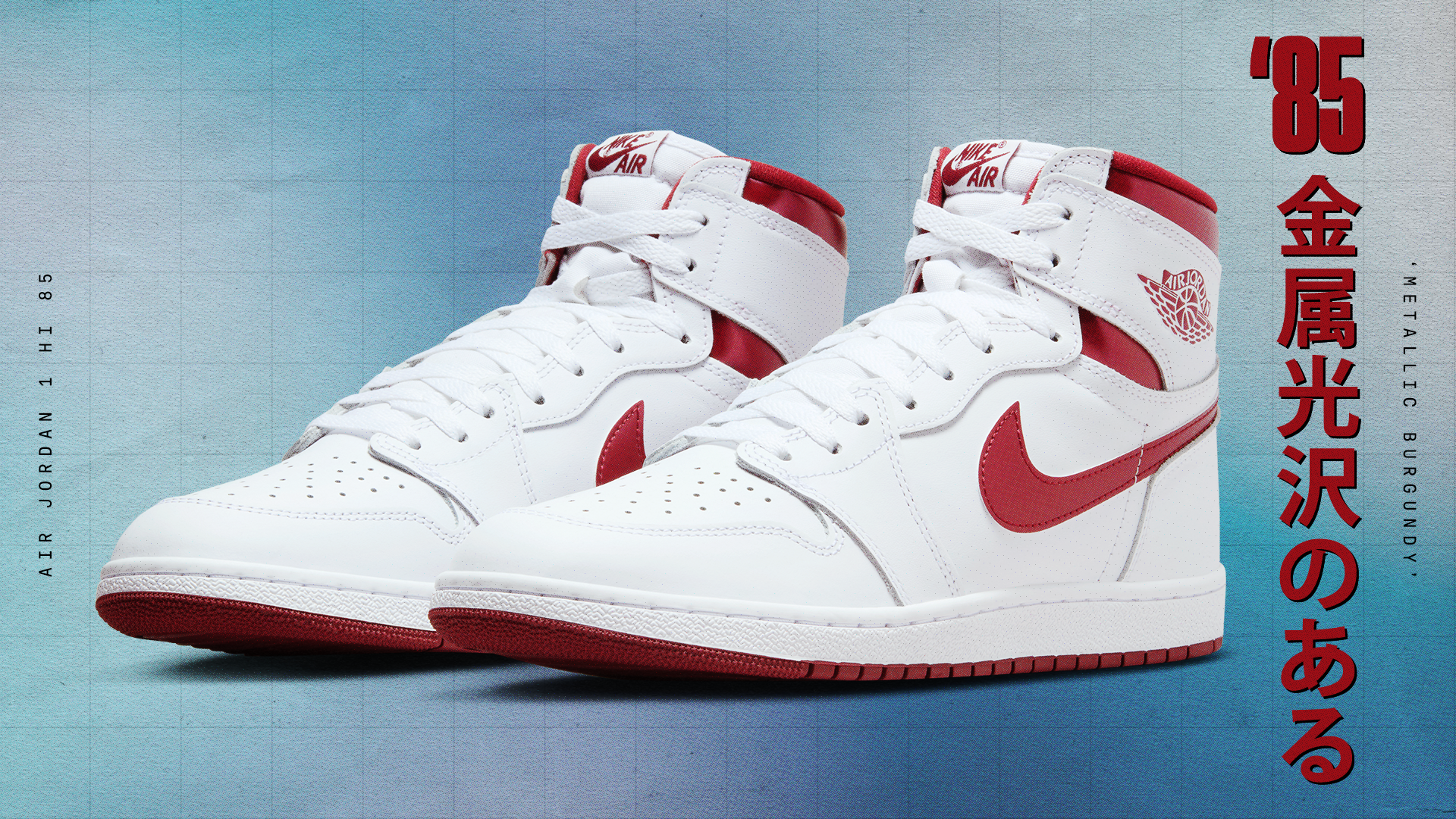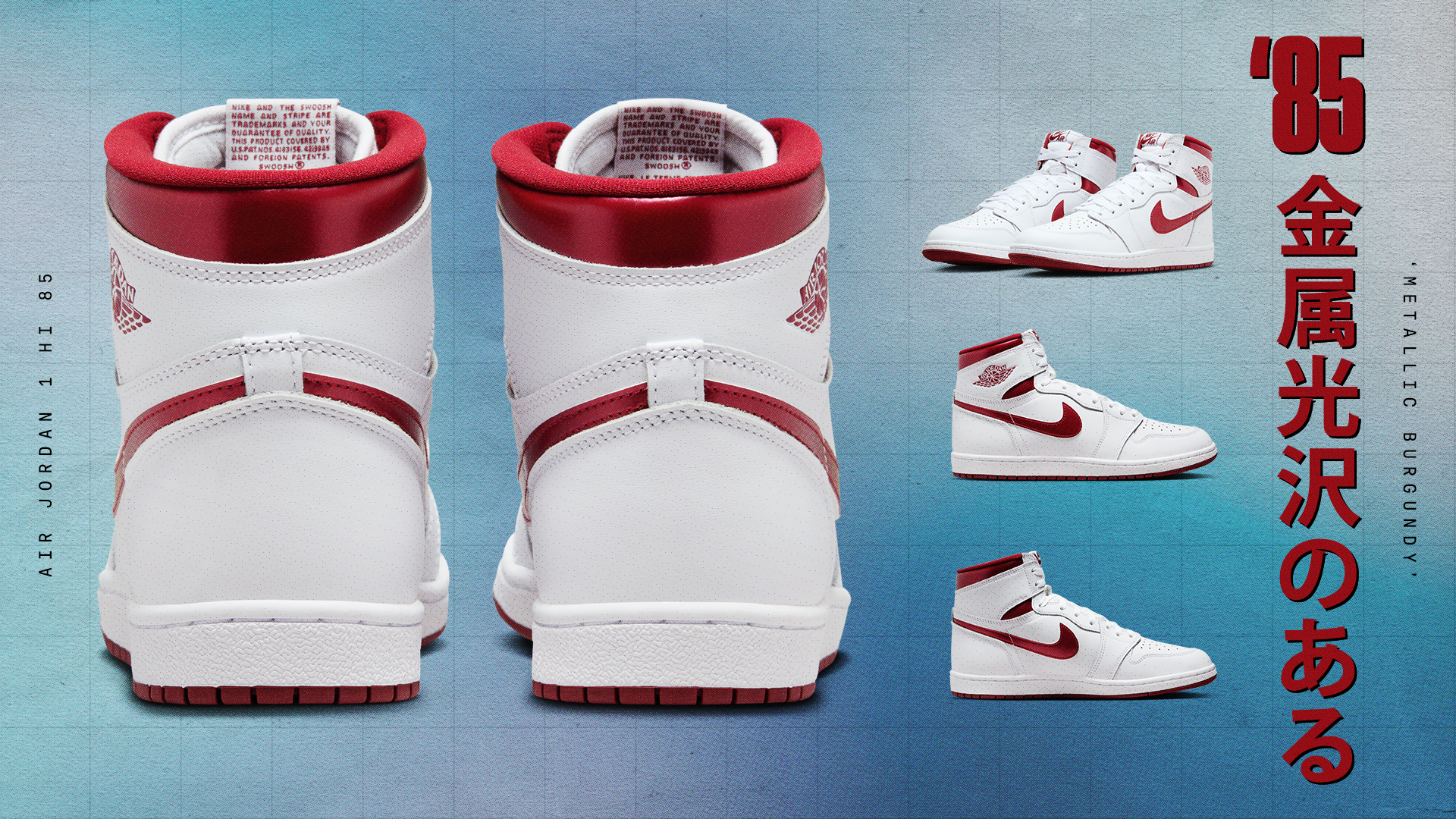
On June 22, Jordan Brand is doing something it hasn’t done in almost 40 years: dropping the Air Jordan 1 ‘85 “Metallic Burgundy,” a retro colorway made to the exact specifications of the original shoe.
That special treatment speaks to the shoe’s history as one of the rarer models among the limited 1985 run of Air Jordan 1 “Metallic” colorways. Where even casual Jordan fans know the line’s first releases, like the “Bred,” “Black Toe,” “Chicago,” and “Royal,” the “Metallic” versions dropped later and were hard to find even in the ‘80s. They remain mysterious and coveted to this day.
To uncover the story of its unique origin and learn why the original Jordan 1 “Metallic” line was so hard to get, Complex examined archival Jordan Brand materials and talked to a Jordan Brand spokesperson.
A Phenomenon and A Problem

From its initial release in 1985, the Air Jordan 1 was a phenomenon. Even beyond its namesake’s game-changing play, the shoe stood out. Nothing else looked like the Jordan 1 in the mid-’80s. Amid a hoard of white basketball sneakers, the first Jordan 1 colorways’ mix of black, red, white, and royal blue were shocking. They were also irresistible. While professional basketball was busy banning the “Bred” colorway for violating league uniform policy, skateboarders, hip hop heads, and rockers were all adopting the shoe as their own.
But the Air Jordan 1’s first run of colorways also posed a problem for Nike.
“With the success of the original colorways, including ‘Royal,’ the company wanted to have an opportunity for more colorways to be extended and seen on court,” the Jordan Brand spokesperson says. But red and black and blue simply didn’t match the uniforms for most teams, particularly at colleges across the United States.
The solution to this problem came from an unexpected source.
Japanese Insight

In 1985, Nike had factories across Asia and an office in Tokyo.
Not only was Japan Nike’s biggest international market at the time, the company’s team in Tokyo was crucial for monitoring production across Asia.
“The Tokyo team worked as liaisons to the factories for the Jordan 1 in Indonesia and South Korea,” the Jordan Brand spokesperson says.
That job wasn’t left to Japan alone, though. Members of the original Air Jordan 1 team based in Beaverton, Oregon, including Bruce Kilgore, would travel to Korean factories in Pusan to fine tune products. Along the way, they’d often have layovers in Tokyo, where they’d visit Nike’s office to work alongside the Japanese staff, as well as with other US-based Jordan 1 team members.
There, the American Jordan 1 team checked in on the Japanese basketball shoe market, learning from their Tokyo counterparts about consumer demands in the country and experimenting with new materials and designs for the shoe.
According to Jordan Brand interviews with Kilgore, in Tokyo, they found Japanese consumers were drawn to unexpected colorways and preferred synthetic materials to leather. That included metallics. The Tokyo Nike team thought synthetic metallics would look good on the Jordan 1 and appeal to Japanese high school and club basketball teams. These insights, derived from Japanese marketplace demands, as well as Nike’s recent use of a metallic gold Swoosh on running shoes for the 1984 Olympics, led the international Jordan 1 teams to experiment with different color combos and metallic materials.
Ultimately, they landed on the Jordan 1 “Metallic” series as we know it today.
“They did them in this synthetic metallic and that just came out of the creative minds of the liaisons in Tokyo and the factory partners,” the Jordan Brand spokesperson says.
Nike even sourced the synthetic metallic material from a Japanese vendor, which had been using it on soccer cleats. Design needs and simplicity drove the sourcing decision.
“That was part creativity and part practicality and resourcefulness,” the Jordan Brand spokesperson says.
With clean white colorways and metallic accents of navy, red, green, orange, purple, burgundy, or black on the Swoosh, Wings, and heel collar, the “Metallic” Air Jordan 1s also solved Nike’s collegiate basketball problem. The “Metallic” series meant college basketball teams across the United States could now wear Air Jordan 1s with their uniforms.
“Colleges in the US got them, these Japanese high schools and club teams got them,” the Jordan Brand spokesperson says.
But echoing its unusual, lesser-known origin story, the “Metallic” line of Jordan 1s was produced in smaller quantities than other Air Jordan 1s, making it rare from the start.
“Because they came in the second or third wave of colorways and they weren't originally intended for scale at retail, they're much more rare,” the Jordan Brand spokesperson says.
That rarity has made “Metallic” Jordan 1s coveted by collectors. Among the handful of original “Metallic” colorways, some have always been much harder to find, and thus more valuable. Black, burgundy, orange, purple, and green seem to be the rarest, with red and navy the most common.
The “Metallic Black” Air Jordan 1 was never released at all, remaining a salesman sample. Although it's not as uncommon as that colorway, the “Metallic Burgundy” is believed to be among the rarest original Air Jordan 1s ever made.
That makes its June 22 re-release even more exciting, giving collectors a chance to buy a shoe that's almost impossible to find in its orginal form.
‘A Very Unique Relationship’

The Tokyo Nike team helped create the Air Jordan 1 “Metallic” line, but that wasn’t their only contribution to Air Jordan 1 culture.
“The Air Jordan 1 in the ’80s has a very unique relationship to Japan,” the Jordan Brand spokesperson says. That’s due to the Tokyo Nike office’s role in sourcing, its hand in designing the “Metallic” series, and the country's status as the company's second biggest market during the decade.
In the mid ’90s, Japanese youth became nostalgic for those cultural connections to the Air Jordan 1. That sparked a craze for vintage Air Jordan 1s in Japan, which dovetailed with a blossoming streetwear scene in the country. In Tokyo neighborhoods like Ura-Harajuku and Ebisu, boutiques popped up selling homegrown apparel brands, vintage clothes, or deadstock sneakers, especially Air Jordan 1s. Japanese magazines emerged to cover nothing but sneakers. In Los Angeles, ads and fliers appeared from vintage dealers seeking ’80s Jordan 1s to resell in Japan. “Metallic” Jordan 1s were among the most valuable.
Around the same time, Nike dropped its first retro Air Jordan 1, in 1994. It was a perfect moment. Air Jordan 1s were in the zeitgeist in Japan and the United States and streetwear was emerging as an influential subculture and industry in Tokyo, New York, and Los Angeles. The sneakerhead scene as we know it now was bubbling up. And Japan’s love for the Air Jordan 1 played a crucial role, helping establish an audience for retro sneakers that’s now a global force.
In this way, Japan helped design the original Air Jordan 1 “Metallic Burgundy” and also proved that there was demand for retro sneakers like that shoe's 2024 re-release.
Undoubtedly, there’s more to learn about the Air Jordan 1, more history to be uncovered, and more mysteries to be solved.
“For the most part, this stuff wasn't documented on paper, it was just created in real time,” the Jordan Brand spokesperson says. “So we're still sort of uncovering the deep history and the rich history. This exploration is actually going to continue to go on well into 2025.”
And 2025 isn’t just any old year. It’s the 40th anniversary of the Air Jordan 1. Which means more special sneaker drops and more to learn.
“The story will get more in depth, more robust, and more accurate as we continue to go on,” the Jordan Brand spokesperson says.
Air Jordan 1 fans can’t wait.


